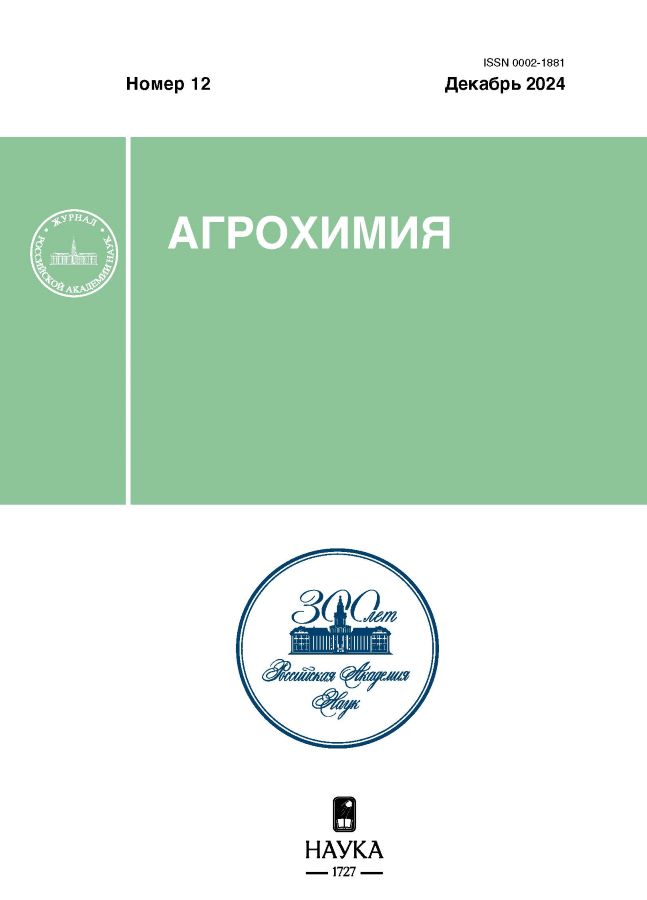Enhancing the effect of phosphorus fertilizers, taking into account liming, taking into account liming in winter wheat cultivation on sod-podzolic soil
- Autores: Bizhan S.P.1
-
Afiliações:
- D.N. Pryanishnikov All-Russian Research Institute of Agrochemistry
- Edição: Nº 12 (2024)
- Páginas: 22-29
- Seção: Experimental Articles. Fertilizers
- URL: https://cardiosomatics.ru/0002-1881/article/view/647242
- DOI: https://doi.org/10.31857/S0002188124120036
- EDN: https://elibrary.ru/vwjowo
- ID: 647242
Citar
Texto integral
Resumo
In long-term field experience on sod-podzolic heavy loamy soil, a significant return was revealed from the use of zinc, copper, magnesium fertilizers, the microbial preparation Bisolbifit together with phosphorus fertilizers in connection with liming in winter wheat crops. The beneficial effect of the studied techniques on grain quality, payback of fertilizers, consumption and utilization rate of phosphorus by plants was noted. On highly acidic, untreated soil with a high content of mobile aluminum (about 130 mg/kg), caused by the systematic introduction of physiologically acidic potassium chloride and ammonium nitrate, phosphorus fertilizers (on average for all the years of the study from 2017 to 2023) provided an increase in winter wheat yield by 69% at a dose of 11.5 tons of lime/ha of medium acid in the soil by 2.2 times, on slightly acidic (19.0 tons of lime/ha) – by 2.7 times, together with the use of trace elements and Bisolbifit – by 2.4 and 2.9 times from the average background level of nitrogen-potassium fertilizers (2.38 t/ha). At the same time, the payback of phosphorus fertilizers with winter wheat grain on slightly acidic soil from the introduction of micro fertilizers and Bisolbifit increased 2.7 times (up to 15.7 kg/kg), the protein content in the grain increased by 1.3%, phosphorus removal by 3.8 times (up to 70.7 kg/ha), the use of phosphorus by winter wheat plants by 2.7 times.
Palavras-chave
Texto integral
Sobre autores
S. Bizhan
D.N. Pryanishnikov All-Russian Research Institute of Agrochemistry
Autor responsável pela correspondência
Email: kzuek@yandex.ru
Rússia, ul. Pryanishnikova 31a, Moscow 127550
Bibliografia
- Аристархов А.Н. Оптимизация полиэлементного состава в агросистемах России – агрохимическая оценка состояния дефицита, резервов, способов и средств его устранения / Под ред. Сычева В.Г. М.: ВНИИА, 2019. С. 200–255.
- Небольсин А.Н., Небольсина З.П. Теоретические основы известкования почв. СПб.: ЛНИИСХ, 2005. С. 90–118.
- Шильников И.А., Сычев В.Г., Зеленов Н.А., Аканова Н.И., Федотова Л.С. Известкование как фактор урожайности и почвенного плодородия. М.: ВНИИА, 2008. 340 с.
- Кук Д.У. Факторы, лимитирующие урожай, и их взаимодействие в системах земледелия // Вестн. сел.-хоз. науки. 1987. № 2. С. 124–130.
- Кулаковская Т.Н. Оптимизация агрохимической системы почвенного питания растений. М., 1990. 218 с.
- Shiwakoti S., Zheljazkov V.D., Gollany H.T., Kleber M., Xing B. Macronutrients in soil and wheat as affected by a long-term tillage and nitrogen fertilization in winter wheat–fallow rotation // Agronomy. 2019. V. 9. P. 178.
- Гомонова Н.Ф. Влияние 30-летнего применения минеральных удобрений на урожай сельскохозяйственных культур и агрохимические показатели дерново-подзолистой почвы // Химия в сел. хоз-ве. 1984. № 1. С. 8–11.
- Kamprath E.J. Exchangeable aluminium as a criterion for liming leached mineral soils // Soil Sci. Soc. Amer. Proc. 1970. V. 34. № 2. Р. 252–254.
- Болдышева Е.П., Попова В.И. Методологические аспекты исследования оптимизации применения микроудобрений под зерновые культуры // Электр. научн.-метод. журн. ОмскГАУ. 2017. № 3(10). С. 2.
- Аристархов А.Н., Бушуев Н.Н., Сафонова К.Г. Приоритеты применения различных видов, способов и доз микроудобрений под озимые и яровые сорта пшеницы в основных природно-сельскохозяйственных зонах России // Агрохимия. 2012. № 9. С. 26–40.
- Shahzad Z., Amtmann A. Food for thought: how nutrients regulate root system architecture // Curr. Opin. Plant Biol. 2017. V. 39. P. 80–87. doi: 10.1016/j.pbi.2017.06.008
- Бахитова А.Р., Кидин В.В. Содержание микроэлементов в зерне ячменя при внесении микроудобрений в разные слои дерново-подзолистой почвы // Плодородие. 2016. № 6(93). С. 27–29.
- Шеуджен А.Х., Бондарева Т.Н., Гуторова О.А., Петрик Я.Б. Медные удобрения в рисовом агроценозе // Плодородие. 2021. № 3(120). С. 62–65.
- Бижан С.П. Влияние совместного применения фосфорных и магниевых удобрений на фоне азотно-калийных на урожайность, качество и вынос элементов питания яровым ячменtм в зависимости от кислотности дерново-подзолистой почвы // Агрохимия. 2023. № 6. С. 39–46.
Arquivos suplementares










